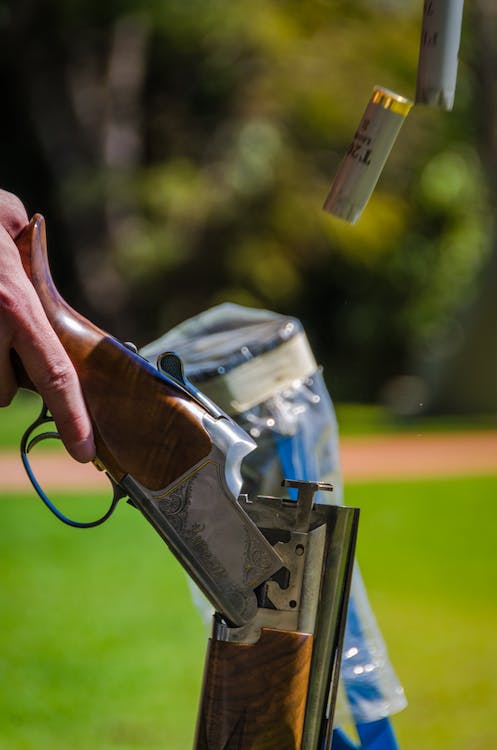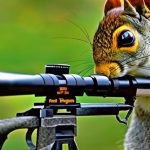Your cart is currently empty!

Miss Less, Hunt More: Unlocking the Secrets of the Best Shot Size for Rabbit and Squirrel!

Table of Contents
Introduction
Hey there, fellow hunters! When it comes to the thrill of small game hunting, there’s nothing quite like the challenge of chasing after rabbits and squirrels. But, as many of us know, even the most seasoned hunter can have an off day if they’re not equipped with the right gear. One crucial factor that might be slipping under your radar is the shot size. Now, you might be thinking, “Does it really matter that much?” Trust me, the difference between a successful hunt and going home with an empty bag often boils down to using the best shot size for rabbit and squirrel. I’ve had my fair share of days spent pondering over which shot size to go for and, over the years, I’ve accumulated a wealth of knowledge about the nuances of this seemingly minor detail. So, buckle up! Whether you’re a newbie trying to bag your first rabbit or a seasoned pro seeking to refine your approach, we’re about to delve deep into the world of shot sizes to elevate your game.
Understanding Shot Size Basics
The Science Behind Shot Sizes
Hey there, fellow hunter! Let’s dive into some nitty-gritty details, shall we? When we talk about shot sizes, we’re referring to the diameter of the shotgun pellets. These can range from tiny pellets perfect for small game to larger ones suited for bigger targets. The shot size you choose plays a significant role in the range and penetration of your shots. Basically, the smaller the number, the larger the pellet. A larger pellet will generally have a longer range and better penetration due to its greater mass. But, as you can guess, that doesn’t necessarily mean it’s the best choice for our furry friends, the rabbit and squirrel.
Commonly Used Shot Sizes for Small Game Hunting
Navigating the world of shot sizes can seem a tad overwhelming, especially with all the numbers flying around. But don’t sweat it; I’ve got your back. For our small game escapades, the most commonly recommended shot sizes are between #6 to #9. Let’s break it down:
- #6 Shot: This size is a favorite among many rabbit hunters. It offers a solid mix of range and pellet density, making it perfect for those bunnies that love to dart about in the open. The pellets are just large enough to ensure a humane kill but not so large that they damage the meat excessively.
- #7.5 and #8 Shot: These sizes are fantastic for those squirrels that love to frolic up in the trees. The smaller pellets ensure a dense pattern, increasing the odds of hitting those agile climbers. While also suited for rabbits, especially in thicker cover, these shot sizes can sometimes lack the knockdown power of #6, especially at longer distances.
- #9 Shot: This one’s a bit on the lighter side, often used for very close-range hunting or for birds. While it can be effective for squirrel, especially if they’re giving you a cheeky stare from a close branch, it may not be the most efficient for rabbits due to its limited penetration.

In the end, the best shot size for rabbit and squirrel often comes down to personal preference and the specific conditions of your hunt. But, by understanding the basics and the advantages of each size, you’re already a step ahead in making an informed choice. Happy hunting, and may your shots be ever accurate!
How Shot Size Affects Pellet Pattern
Pellet Spread and Its Significance
Alright, folks, let’s chat about pellet spread. Imagine this: you’re out in the woods, the sun’s setting, and right there in the clearing is that rabbit you’ve been tracking. You take aim and fire, but miss by a whisker. What went wrong? Often, it’s not just your aim but the pellet spread that determines success.
The spread refers to how the shot pellets disperse after leaving the barrel. Pellet density plays a pivotal role here. A denser pattern, packed with smaller pellets, might increase your chances of hitting a target. Think of it as casting a wider net to catch a moving fish – or in our case, a speedy rabbit or darting squirrel. That said, a dense pattern isn’t always ideal. It could result in multiple hits, damaging the meat or pelt. So, while a denser spread might improve your chances, it’s crucial to consider the range and the game’s size.
Barrel Choke and Its Relationship with Shot Size
Now, on to another integral component: the barrel choke. If you’re scratching your head, don’t worry. Think of the choke as a funnel at your shotgun’s muzzle end. Its primary job is to control the pellet spread. By tightening or loosening the choke, you can manipulate the shot’s dispersal pattern, making it broader or narrower.
Let’s break down the types:
- Full Choke: This one’s the tightest of the lot. It keeps your pellets together for longer, making it ideal for longer-range shots. Pairing this with a larger shot size like #6 can be lethal for rabbits scampering in open fields.
- Modified Choke: The middle ground. It offers a medium spread, versatile for both rabbits and squirrels at varying distances. A #7.5 or #8 shot would go hand in hand with this choke, especially in areas with mixed terrains.
- Improved Cylinder: The most open of the chokes. It lets your pellets spread out sooner, perfect for those close-range shots when Mr. Squirrel decides to play hide-and-seek. Combine this with a #8 or #9 shot, and you’re in for a treat.
Pairing the right choke with the best shot size for rabbit and squirrel is like finding the perfect dance partner. It’s about rhythm, timing, and a bit of personal flair. By understanding these two elements and how they complement each other, you’ll not only elevate your hunting game but also ensure every outing is a memorable one.
Ethical Hunting and Shot Size
Importance of a Clean and Humane Kill
Hello again, fellow hunters. We’ve chatted about the ins and outs of shot size, but there’s one aspect that often goes unspoken in hunting circles, and that’s ethics. Ethical hunting isn’t just a buzzword—it’s a philosophy that should guide every decision we make in the field. At the heart of this is the commitment to a clean and humane kill.
The shot size you choose plays a paramount role in this. There’s a delicate balance between ensuring a kill and minimizing the suffering of the animal. Too large a pellet and you risk excessive damage; too small, and you might not ensure a quick end. Marrying the correct shot size with the right distance is essential. For instance, a #6 shot might be perfect for a rabbit at a medium range, ensuring a swift kill. On the other hand, if you’re up close and personal with a squirrel, a smaller shot like #9 may be more appropriate to avoid excessive damage while still ensuring efficiency.
Preserving the Pelt: How Shot Size Can Impact Quality
Now, for those of us who cherish the pelt as much as the hunt, shot size becomes even more crucial. The quality of the pelt can be directly affected by the shot size you use. Let’s break it down:
- Larger Shot Sizes (#6 for instance): These tend to leave larger entry points, potentially damaging the pelt more noticeably. Especially if you’re hunting for commercial purposes, this could reduce the pelt’s value. But there’s a silver lining – a larger shot size typically ensures a quicker and cleaner kill, thus aligning with our ethical hunting practices.
- Smaller Shot Sizes (#8 or #9): These produce less noticeable damage to the pelt, making them ideal for those looking to sell or preserve the skin. However, always bear in mind the range and the size of the game to ensure the shot is effective.
For hunters keen on keeping their pelts in pristine condition, here are a few tips:
- Aim True: Aim for the head or vital organs. This ensures a quick kill and lessens potential damage to the rest of the pelt.
- Mind the Distance: The closer you are, the tighter the pellet spread, which reduces the chances of multiple entry points on the pelt.
- Storage Matters: Once you’ve bagged your game, store it properly to preserve the pelt’s quality. A cool, dry place works best until you can process it.
Remember, while the thrill of the hunt is a driving force, our respect for nature and the game should always come first. Choosing the best shot size for rabbit and squirrel with these principles in mind ensures we honor the hunt and the hunted.
Related Questions
Can I use the same shot size for other small game animals?
Absolutely! While the best shot size for rabbit and squirrel tends to fall between #6 to #9, this range also works pretty well for other small game critters. Take quail or grouse, for example; many hunters find success with sizes like #7.5 or #8. It’s all about understanding the game’s size and behavior. That said, always do a bit of research or consult with fellow hunters to fine-tune your choice for specific animals.
How does distance affect the efficiency of my chosen shot size?
Distance is a game-changer, quite literally. The farther away your target, the more your shot will spread out by the time it reaches its destination. For distant shots on, say, a darting rabbit, a larger pellet like #6 might have better range and penetration. Conversely, if you’re up close, a dense pattern with smaller pellets (#8 or #9) increases your hit chances without causing excessive damage. Always gauge your distance and adjust your shot choice accordingly!

What are the environmental considerations when selecting shot size and type?
Great question! Beyond the hunt, it’s essential to think about Mother Nature. Traditional lead pellets can be toxic to the environment. Thankfully, there are eco-friendly alternatives like steel, bismuth, or tungsten. These materials are less harmful to water sources and wildlife. While they might cost a bit more, they’re a worthy investment in preserving our hunting grounds for future generations. When choosing shot size, consider biodegradable wads to further minimize environmental impact.
Are there any recommended brands or types of ammo for rabbit and squirrel hunting?
You bet! When it comes to hunting ammo, reliability is key. Brands like Federal, Winchester, and Remington have long-standing reputations for quality. For our furry friends, the rabbit and squirrel, consider Federal’s Game-Shok or Winchester’s Super-X line. Both offer a variety of shot sizes tailored for small game. But remember, every gun is a bit different, so it’s a good idea to experiment with a few brands to find the one that syncs best with your firearm.
Summary
And there you have it! From understanding the basic science behind shot sizes to weighing ethical considerations, it’s evident that making an informed choice can seriously enhance your hunting experience. After all, hunting isn’t just about the thrill of the chase; it’s also about respect for the animal and our environment. By choosing the best shot size for rabbit and squirrel, you’re not only increasing your chances of success but also ensuring a humane approach. Remember, every small detail counts, and something as simple as the right shot size can turn your hunting escapades from mediocre to memorable. So next time you’re preparing for a day out in the wilderness, give a nod to this guide and make your selection with confidence. Happy hunting, and may your shots always find their mark!

Herb has been a longtime lover of the outdoors. Whether it be hunting, camping, fishing or just getting outside to reset. Proud father and animal lover. Bourbon anyone?

by
Tags:
Comments
3 responses to “Miss Less, Hunt More: Unlocking the Secrets of the Best Shot Size for Rabbit and Squirrel!”
-
[…] Old Oak Syndicate’s website to discover the ideal shot size for rabbit and squirrel hunting: https://oldoaksyndicate.com/best-shot-size-for-rabbit-and-squirrel/. Happy […]
-
[…] it comes to your ammunition choices. Don’t miss out on this essential information – click here to read the full […]
-
[…] size can greatly enhance your success in targeting rabbits and squirrels. Check out the article here to improve your hunting skills and make the most of your 7mm-08 […]

Categories
- Big Game Hunting (301)
- Deer (202)
- Reviews (3)
- Shooting (16)
- Slingshot (1)
- Small Game Hunting (42)
- Upland Hunting (126)
- Waterfowl Hunting (3)





Leave a Reply